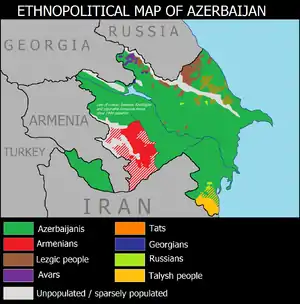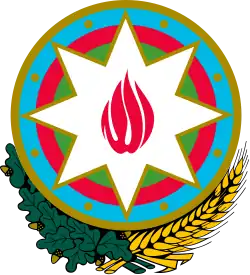Languages of Azerbaijan
Azerbaijani is the official and majority language of Azerbaijan, yet there are numerous minority languages in the country.

General
The primary and official language of Azerbaijan is Azerbaijani, Azeri,[1][2] a Turkic language closely related to and partially mutually intelligible with Modern Turkish.[3] Together with Turkish, Turkmen and Gagauz, Azerbaijani is a member of Oghuz branch of southwestern group Turkic language family. Although Azerbaijani is used in the Republic of Azerbaijan, South Russia (Dagestan) and Northern Iran, the dialects are different. Furthermore, Azerbaijan is recognized as an official medium of instruction in Dagestan and in the Republic of Azerbaijan, however, it is not an official language in Northern Iran where the number of Azerbaijanis exceed the ones in the Republic of Azerbaijan itself. The Azerbaijani language spoken in Iranian Azerbaijan is quite different from the one spoken in North Azerbaijan and instead of promoting the use of language, the Iranian government has discouraged and even banned it for several decades.[4]
Present
According to the 2009 census of the country, Azerbaijani is spoken as a native language by 92.5% of the population,[5] whereas Russian and English play significant roles as languages of education and communication. More than half of Azerbaijani speakers are monolingual.[4] The large Armenian-speaking population of Nagorno-Karabakh is no longer under government control. Lezgian, Talysh, Avar, Georgian, Budukh,[6] Juhuri,[6] Khinalug,[6] Kryts,[6] Jek,[7] Rutul,[6] Tsakhur,[6] Tat,[6] and Udi[6] are all spoken by minorities. All these[8] (with the exception of Armenian, Lezgian, Talysh, Avar, and Georgian, which have a much larger number of speakers outside Azerbaijan, but nevertheless are steadily declining within Azerbaijan) above-mentioned languages are endangered languages which are threatened with extinction, as they are spoken by few (less than 10,000) or very few (less than 1,000) people and their usage is steadily declining with emigration and modernisation.
According to 2019 research English language proficiency in Azerbaijan was lowest among surveyed European countries.[9]
An entire issue of the International Journal of the Sociology of Language, edited by Jala Garibova, was devoted to the matter of languages and language choices in Azerbaijan, vol. 198 in 2009.[10]
Azerbaijan has not ratified the European Charter for Regional or Minority Languages to which it became a signatory in 1992, under the Popular Front. In 2001, the then President of Azerbaijan Heydar Aliyev issued a statement whereby "the Republic of Azerbaijan is not in the power to guarantee the implementation of the Charter regulations until its territory occupied by the Republic of Armenia is liberated".[11]
History
The medieval author Ibn al-Nadim, in his book Al-Fihrist mentions that all the Median and Persian lands of antiquity (including what is today the Republic of Azerbaijan) spoke one language. There, he quotes the great scholar Abdullah Ibn al-Muqaffa:
- "The Iranian languages are Fahlavi (Pahlavi), Dari, Khuzi, Persian, and Seryani. But Fahlavi comes from the word Fahleh. And Fahleh is a name that refers to 5 regions: Isfahan, Ray, Hamedan, Mah-Nahavand, and Azerbaijan."
He then reports that Dari is the official language of the royal courts, and is from Khorasan and Balkh and eastern Iran; Parsi is the language of the Zoroastrian Moobeds, and is from Fars; Khuzi is the unofficial language of royalty and is from Khuzestan; and Seryani originates from Mesopotamia.
This has also been reported by reputed medieval historians such as Al-Tabari, Ibn Hawqal, Istakhri, Moqaddasi, Yaghubi, Masudi, and Mostowfi Qazvini as well. Al-Khwarizmi also mentions this in Chapter 6, Vol. 6, of his book Mafatih-ol-Olum.
Etymological studies also further indicate that current dialects spoken from Baku through Khalkhal to Semnan, all originated from a common source. In other words, the people of ancient Azerbaijan spoke the same language spoken by the Medes. (See Columbia University's distinguished professor Ehsan Yarshater's report in: Majjaleh-ye Daaneshkadehye Adabiyaat, 5, No 1–2, p35-37)
The medieval historian Yaqut al-Hamawi also used the phrase Al-ajam-ol-Azariyah ("The Azeri Iranian") in his books Mo'ajjem ol-Odabaa and Mo'jem ol Baladaan. In other sources such as Surat-ol-Arz by Ebne Hoghel, Ahsan ol-Taqaaseem by Moqaddasi, and Masaalik va Mamaalik by Istakhri, the people of Azerbaijan are recorded as having spoken Iranian languages. Obviously, this was before the Turkic cultural arrival. And Tabari in 235 A.H. also mentions that poets in Maragheh recited poetry in Pahlavi. Some Azerbaijani poets however, such as Qatran Tabrizi (d465 A.H.), used the word "Persian" and "Pahlavi" interchangeably to describe their native language.
The historian Hamdollah Mostowfi even goes as far as describing variants of "Pahlavi" spoken in different areas of Azerbaijan. In his book Tarikh Gozideh, he describes eight poets from Azerbaijan, calling them "Ahl-ol She'r Men-al-Ajam" (Iranian poets), all Persian=speaking. By now, of course, Dari and Pahlavi had merged into one, as successive dynasties moved from east to west, bringing with them the Dari version of the Iranian language.
Suffice it to say that the number of records and documents from Azerbaijan in the Pahlavi language are so numerous that there is little doubt that this was indeed the native tongue of Azerbaijan before the arrival of the Turks. Many words in the current Azeri vocabulary are in fact of Pahlavi origin. (See studies in Nashriyeh Adabiyaat of Tabriz University, by Dr Mahyar Navabi, 5, 6. Also, see Farhang e Kamaleddin Teflisi and Ajayeb ol-Makhluqaat by Najibeddin Hamadani, and the books Majmal-ol-Tavarikh wa al-qasas and Iskandar-Nameh e Qadeem for lists of words.)
It is agreed that the current Turkic form of the Azeri language supplanted and replaced Pahlavi in Azerbaijan before the Safavid dynasty, perhaps starting with the arrival of Seljukian Turks, and following a gradual course. But some historians report Pahlavi being spoken in Tabriz as late as the 17th century. (See Rowdhat ul-Jinan by Hafez Hosein Tabrizi (d997 A.H.), and Risaleh ye Anarjani written in 985 AH). Even the Ottoman Turkish explorer Evliya Celebi (1611-1682), mentions this in his Seyahatname. He also reports that the elite and learned people of Nakhichevan and Maragheh spoke Pahlavi, during his tours of the region.
References
- "Azerbaijan". www.ethnologue.com. Retrieved 14 September 2013.
- "Constitution of the Republic of Azerbaijan" (PDF). President of the Republic of Azerbaijan. Official Website of the President of the Republic of Azerbaijan. Retrieved 31 August 2020.
- Sinor, Denis (1969). Inner Asia. History-Civilization-Languages. A syllabus. Bloomington. pp. 71–96. ISBN 0-87750-081-9.
- Keith, Brown; Ogilvie, Sarah (2008). Concise Encyclopedia of Languages of the World 1st Edition. Elsevier Science. p. 110. ISBN 9780080877754.
- "UNdata | record view | Population by language, sex and urban/rural residence". Data.un.org. 2015-12-24. Retrieved 2016-01-29.
- Published in: Encyclopedia of the World's Endangered Languages. Edited by Christopher Moseley. London & New York: Routledge, 2007. 211–280.
- Н. МАРР : "Яфетические языки", Большая сов. энциклопедия, 1-е изд., т. 65, Москва : Сов. Энц., 1931, стр. 841. Archived 2012-10-28 at the Wayback Machine
- "Atlas of the World's Languages in Danger". UNESCO.
- "EF EPI 2019 – Europe". www.ef.com. Retrieved 2019-11-08.
- International Journal of the Sociology of Language, Volume 2009, Issue 198 (Jul 2009), http://www.degruyter.com/view/j/ijsl.2009.2009.issue-198/issue-files/ijsl.2009.2009.issue-198.xml
- Azərbaycan Respublikasının Regional dillər və ya azlıqların dilləri haqqında Avropa Xartiyasına dair bəyanatı. 20 December 2001. Retrieved 17 February 2017.

